Tools you can use.
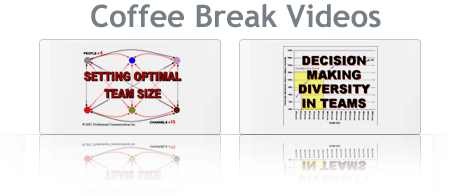
Coffee Break Videos
This section offers movies from a variety of perspectives. Most movies are less than 10 minutes in length.
The movies can be used for individual learning or as a component of programs and consulting debriefings.
For Everyone
“I Opt” Advanced Leader Report Orientation ~ 9 MIN
This movie reviews the report that shows how “I Opt” styles and patterns create themes, strengths and vulnerabilities. Relations with individuals, groups and superiors are covered.
Keywords: ”I Opt“, leader, leadership, styles, patterns, strategies, strengths, vulnerabilities, themes, learning, executive, individual, group, team

“I Opt” LeaderAnalysis™ Orientation ~ 17 MIN
This is an introduction to the I Opt Leader Analysis report. The report analyzes the leader in the context of the specific group of people being led. This movie offers extensive explanations of analytical technique as well as the construction of the various supporting graphics.
Keywords: I Opt, leader, leadership, styles, patterns, strategies, strengths, vulnerabilities, coalitions, executive, manager, staff, decisions, corporate, team dynamics, individual, group, majority, consensus, pinwheel, leader pull, compatibility, cross compatibility matrix, communication, team size.
“I Opt” LearningReport™ ~ 10 MIN
Learning is an information processing activity. "I Opt" strategic styles define a person's preferred approach to this activity. The Learning Report shows how a person might best approach learning from their particular strategic style election.
Keywords: I Opt, learning, report, styles, patterns, strategies, strengths, vulnerabilities, coalitions, executive, manager, staff, decisions, corporate, team dynamics, individual, group, majority, consensus, pinwheel, compatibility, cross compatibility matrix, communication, team size.
“I Opt” Coaching Report used for Self-Study ~ 10 MIN
This movie shows how the Coaching Report can be used as a self-study tool. It shows how the Coaching Report ties into the Advanced Leader Report on a page-by-page basis.
Keywords: “I Opt”, Socratic Method, leader, leadership, styles, patterns, strategy, strengths, vulnerabilities, themes, learning, executive, individual, group, team
“I Opt” TeamAnalysis™ Orientation ~ 10 MIN
This movie walks the viewer through each of the three sections of the I Opt TeamAnalysis Report. It shows how the viewer can use the report and I Opt technology to improve team performance.
Keywords: “I Opt” strategic style, strategic pattern, strategic profile, strengths, vulnerabilities, leadership, team dynamics, individual, group, team personality, majority, consensus

“I Opt” Individual Report Orientation ~ 8:30 min
This movie explains the basis of ‘I Opt” technology in simplified form. It then provides a page by page explanation of the report contents.
Keywords: ‘I Opt” s trategic Style, explanation, theory, teams, learning, application, guidance, teams, learning

“I Opt” Emotional Impact Management Report — 9:40 MIN
This movie describes how the emotional responses of others can be predicted and managed using I Opt strategic style technology. Both short and long-term emotional relationships are addressed
Keywords: “I Opt” strategic patterns, social intelligence, emotional intelligence, emotions, feelings, leadership, emotional cascades, attribution, mirror strategy, mirroring

“I Opt” Sales Report ~ 10min
This movie shows how “I Opt” technology can be used to improve sales performance. The integration of sales with other staffs is addressed as are self-management issues for the individual sales person
Keywords: Sales, sales training, ÒI OptÓ strategic styles, strategic patterns, test, assessment, support staffs, product knowledge, prospecting, presentation, closing , referrals, telemarketing, goals, selling, sales profile
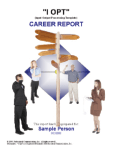
“I Opt” Career Report Orientation ~ 6 min
This movie shows how “I Opt” technology can be used to identify and leverage natural strengths into long-term career success.
Keywords: “I Opt” strategic style, strengths, exposures, guidance, career navigation, elevator pitch, success formula, favorable positions, teams
“I Opt” Change Management Report Orientation ~ 10 min
The “I Opt” Change Management Report is designed to address group as well as individual adjustment challenges. It includes an explanation of “why” difficulties can be encountered in change situations as well as “what” can be done to address them.
Keywords: “I Opt” I Opt, I-Opt, change, team, information processing, behavior, styles, patterns, adjustment, differences, challenges, mutual consideration
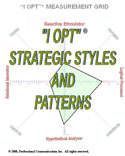
“I Opt” Strategic Styles and Patterns ~ 8:30 min
This movie explains how styles and patterns work together to set both short and long term decision making behavior. Common experiences are used to illustrate concepts.
Keywords: ‘I Opt” strategic styles, strategic patterns, ‘I Opt” Grid, measurement, short & long run, decision behavior.
For Professionals

Diversity in the Scientific Community ~ 15 MIN
This video summarizes and extends the content of a chapter titled Gender and Thought Diversity that we were invited to contribute to a peer-reviewed book published in the spring of 2017 by the American Chemical Society. The video shows how Sociology and Engineering can be combined using "I Opt" technology. This combination can then be used to accurately predict and guide the probable reactions of both groups and individuals to external contextual situations—including culture. The video goes on to demonstrate its application by applying the technology to a real situation being confronted in the chemical community. The video accomplishes this by drawing on the results six evidenced-based studies that are a part of our continuing research into contemporary issues in modern society. The video shows that a cause of the current participatory shortfall of women in science and engineering is complex but understandable. This understanding can greatly improve corrective initiatives.
"I Opt", I Opt, I-Opt, information processing, women, men, Engineering, Science, chemistry, diversity, culture, Sociology, Psychology, theory, validity, measurement, false equivalency, process engineers

Information Technology: How Different Are We? ~ 16 MIN
This evidence-based research samples 3,673 IT people from all levels (Sr. executives, mid-management, professional staffs). It compares these people to 44,448 non-IT people from similar levels in other organizational functions. The study found statistically significant differences that show IT is in a natural leadership position.
The differences found are not great. This is seen as a positive. IT leadership can be exercised while preserving a common culture and with minimal dysfunctional turmoil. The study provides evidence that IT departments in diverse firms are more alike than different. This means that the IT discipline as a whole is likely to exhibit a consistently positive leadership momentum across the various industries in which IT participates.
The study found that IT people were more different from each other internally than IT is externally different from other non-IT functions. Finally, the study compared IT to engineering. It found a near identity in approach. It also found that this identity was due to IT women. IT men were substantially different from their male engineering counterparts.
"I Opt", I Opt, I-Opt, information processing, IT, executive, mid-management, professional, engineering, measurement, organization, structure, women, men, difference, development

IT Senior Executive Organizational Fit ~ 16 MIN
Evidence-based measurements are used to determine the overall standing of senior IT executives among the other executives in Senior Management. A Deloitte Consulting (2015) study gave estimates of IT satisfaction with reporting relationships. “I Opt” technology was applied to extend Deloitte’s data and showed that IT satisfaction directly related to information processing profile overlaps between the levels. A sample of 470 CEO’s, 90 CFO’s, 44 COO’s and 264 General Managers showed different predictable points and degrees of tension could be identified for each of the different potential reporting structures. The study also compares 147 senior IT executives (58 firms, 8 countries) with 1,511 non-IT VP’s. The overall “fit” was measured and points of opportunity and exposure are identified.
"I Opt", I Opt, I-Opt, information processing, IT, executive, measurement, CEO, CFO, COO, General Manager, reporting, organization, structure, Deloitte, satisfaction

Gender Bias in Engineering: Root Cause ~ 16 MIN
This video summarizes research on 5,130 degreed engineers, 4,266 men and 864 women. The research finds systematic differences between men and women engineers that effect how engineering is done. These objectively verifiable differences support gender bias but are subtle and easily masked within the profession. They are, however, convincingly evidenced in the low participation rate of women in engineering. The study offers strategies for resolving the root cause and ameliating it in the interim. The study is fully documented in the research blog is available from the home page of www.iopt.com.
"I Opt", I Opt, I-Opt, bias, gender, engineering, information processing, TeamAnalysis, dominant styles, action, thought, pattern based, STEM, retention, sociology, skepticism, talent, women, men

Engineering Professors: Gender Gatekeepers ~ 12 MIN
This evidence-based study analyzes a sample of 155 engineering and 285 non-engineering tenured and tenure track professors. The study finds that the engineering professor's information processing elections are unique among their academic peers. This difference offers a functional advantage in the conduct of their professional responsibilities. However, it can also be an impediment in their ability to incorporate the latent talent of women into the profession. The research measures the degree differences with non-engineering professors. It also identifies a root-cause source of a difficulty in increasing the participation of women. A fact-based strategy for remedying the condition in a way that preserves the integrity of the field is offered.
"I Opt", I Opt, I-Opt, engineering, professor, tenure, tenure track, information processing, women, men, engineer, participation, style, pattern, STEM, biology, chemistry, university, cortisol, epinephrine, oxytocin

Summary of Women in Engineering Leadership ~ 2 MIN
This is a 2 min video analyzing the gender structure of engineering management using a sample of 543 women and 2,771 men. The summary covers some of the main points addressed in the longer video. A research blog accessible on the www.iopt.com homepage offers detail statistics and elaboratons.
Keywords: "I Opt", I Opt, I-Opt, information processing, women, men, VP, Chief Engineer, engineer, participation, management, style, pattern, STEM, women, men, standards, culture, personality.

Women in Engineering Leadership ~ 14 MIN
This evidence-based study analyzes the gender structure of engineering management using a sample of 543 women and 2,771 men. The study finds that there is an underlying dimension that disproportionately limits women's participation in management. This limit is imposed by the nature of the women attracted to and willing to remain in engineering. The limit is compounded by the nature of the management structure that is otherwise optimally attuned to the engineering mission. Focusing on STEM education exclusively will misdirect at least a portion of the initiatives intended to correct the situation. A research blog accessible on the www.iopt.com homepage offers detail statistics and elaborations.
Keywords: "I Opt", I Opt, I-Opt, information processing, women, men, VP, Chief Engineer, engineer, participation, management, style, pattern, STEM, women, men, standards, culture, personality

Engineering Insights - 2 Minute Summary ~ 2 MIN
This video condenses the 13 minute Engineering Insights video. That video reports on research using 4,240 individuals from all levels of the engineering contrasted with 29,893 individuals from other professional areas. The study demonstrates that engineering has a unique structure characterized by high similarity. This was judged to be optimal but generated potentially detrimental side-effects. The VP position was found to be unique within engineering and also among other professions. The uniqueness was found to be an operationally functional adaptive mechanism.
Keywords: "I Opt", I Opt, I-Opt, engineering, management, information processing, profile, culture, strategy, Vice President, supervisor, manager, TeamAnalysis, LeaderAnalysis, sample, norms, stereotype, social, MBA, EMBA

Engineering Insights ~ 13 MIN
This video reports on research using 4,240 individuals from all levels of the engineering from Vice President to professional engineer. They are contrasted with 29,893 individuals from other professional areas. The study was able to determine that engineering has a unique structure characterized by high similarity. This was judged to be optimal but generated potentially detrimental side-effects. Strategies for controlling these exposures are offered. The VP position was found to be unique within engineering and also among other professions. The basis of this uniqueness was found to be an operationally functional adaptive mechanism.
Keywords: "I Opt", I Opt, I-Opt, engineering, management, information processing, profile, culture, strategy, Vice President, supervisor, manager, TeamAnalysis, LeaderAnalysis, sample, root cause, norms, stereotype, social, MBA, EMBA

Women in Engineering ~ 17 MIN
The National Science Foundation (NSF) and U.S. Census have both identified engineering as having the lowest female participation rate among the STEM occupations. An analysis of the NSF data shows that a gender bias exists throughout all areas of engineering that does not exist in the exact sciences—an area with equivalent structural demands. A sample of 2,855 working professional engineers without supervisory responsibilities is contrasted with 619 professional scientists to help isolate differences in both male and female populations that explain an underlying cause of the condition. A research blog accessible on the www.iopt.com homepage offers detail statistics and elaboratons.
"I Opt", I Opt, I-Opt, information processing, women, men, scientist, engineer, participation, National Science Foundation, census, style, pattern, STEM, female, male, standards, culture, role, personality

3-Dimensional Organization Charts ~ 9 MIN
The actual organization of a small public university with a staff of about 700 people was used to demonstate the value of 3-dimensional organizational charts. The ability to rotate the charts in 3-dimensional space provides a powerful means of focusing attention in a compelling manner. This can be use to provide a common basis for better understanding the complexity of the organizational issues being confronted. In addition, the video suggests how the 3D tool might help to relax judgemental biases, demonstrate the value of leadership skills and explain the need for meetings. The free and easy to use 3D program employed in developing the video is cited in the presentation.
Keywords: "I Opt", I Opt, I-Opt, information processing, profile, organization, chart, 3-Dimensional, Sketchup, organization chart, leadership, Consultants Package, core mission, university, meetings, memos

The Engineering Personality ~ 15 MIN
The "personality" of 2,135 professional engineers are defined, measured and contrasted with 8,011 professionals from other 8 other disciplines. The unique nature of the people attracted to the engineering discipline is isolated and the implications for STEM based initiatives are evident. The research traces the origin and shows how many of the qualitative characteristics commonly associated with an "engineer personality" naturally arise from a behavioral cascade. It goes on to show how measuring the information processing element can be used to allocate engineers to optimal areas and combine them into effective teams.
Keywords: "I Opt", I Opt, I-Opt, personality, STEM, engineer, chief engineer, engineering, VP, information processing, profile, skew, predict, behavior, cascade, inference, generalization, styles, snowflake, teams, Hypothetical Analyzer
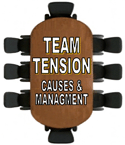
Team Tension — Causes and Management ~ 15 MIN
A universal form of team tension is shown to arise from a specific cause that is inherent in any team doing anything. The cause is embedded in the character of information that a team needs to fulfill its function. This means that tension cannot be avoided, it can only be managed. The study proceeds to offer specific strategies that can be used to minimize tension exposure or to mitigate tension effects when it cannot be avoided. The strategies offered are specific to the degree and direction of tension being experienced or anticipated.
"I Opt", I Opt, I-Opt, team, tension, dysfunction, conflict, cause, information, dynamic, anxiety, strain, style, strategy, profile, emotion, judgement, information processing, logic, accusation, insistence, attribution, malfunction, performance, teamwork, rules, roles, process, TeamAnalysis

Secrets of the Administrative Assistant ~ 14 MIN
A sample of 194 Administrative Assistants from 100 different firms and institutions were used to identify behavioral stances that are not readily visible (i.e., secrets). The Administrative Assistant role is shown to be unique and highly specialized in terms of its approach to work issues. The research uses over 5,000 people in professional roles as well as people in a range of management positions up to and including the CEO to show the distinctive nature of the Administrative Assistant position.
"I Opt", I Opt, I-Opt, secrets, strategic style, unpatterned, structured, action, thought, analysis, team, Administrative Assistant, Executive Assistant, Secretary, CEO, professionals, role, nurses, teachers, network, RS, LP, HA, RI, conflict, tension, strategy, workload, logic, facts, change.

Creativity Science ~ 13 MIN
Creativity has stable and identifiable component parts. "I Opt" technology distinguishes three distinct and independently controllable elements of creativity: volume of ideas, the direction of the creative initiative and the quality of the ideas created. Using these new insights professionals can tailor their initiatives more precisely. The research also forms a foundation for extended scientific research into the subject.
Keywords: "I Opt", I Opt, I-Opt, knowledge, creativity, quality, Peter Meusburger, input, output, process, ideas, strategic style, strategy, style, profile, Brainstorming, Brute Think, unpatterned, structured, action, thought, analysis, experimentation, "connect the dots," tension, team, science

University Management ~ 11 min
The information processing structure of universities is studied though a sample of 732 positions at over 100 different universities. The study focused on four management levels - Professors, Directors, Administraton and Staff. Statistics reveal that there are structural disjoints that will result in persistent organizational strains. These structural "disjoints" need not be corrected. They are necessary for the effective functioning of the university.
Keywords: “I Opt”, Administrator, I Opt, I-Opt, knowledge, management, manager, organization, professors, profile, strategic style, strategy, style, supervisor, University

Predicting “I Opt” Strategic Style Change ~ 15 min
A study to determine the degree and direction of change in strategic styles over time was conducted. It used 1,515 test-retest sets of surveys covering a time span of 1 day to over 12 years. The study included 132 distinct firms/institutions including profit, non-profit, universities and governmental entities.
The research found that styles do change, although typically by modest amounts. Observed changes in dominant style are shown to be principally a function of the rank order (i.e., ordinal) measure rather than substantive changes in observable behavior.
The direction of change in styles is shown to be entirely predictable. The study was also able to isolate strategic styles that were particularly resistant to change.
Keywords: “I Opt”, strategic style, style change, test-retest, statistical significance, dominant style, secondary style, analysis, strategy, profile, survey, ordinal, rank order, exact, measurement, environment

Sales Management and Performance ~ 9 min
This video summarizes evidence-based research based on a sample of 711 sales/marketing professionals and executives from 193 different companies. The study found systematic, statistically significant differences between the between levels in the sales organization. The practical implications of this finding include guidance on promotional selection and training. The study also found statistically significant differences between sales and marketing professionals and by type of sales (i.e., transactional vs. relationship). The practical implications that flow from both of these findings are outlined.
Keywords: “I Opt”, styles, sales, marketing, transactional selling, relationship selling, executive, manager, professional, promotion, sales performance, strategic profiles, strategic styles, information processing, measurement, significance tests, sales seminars, sales teams, sales styles, selection, organizational tension.

“I Opt” Split Style Explained ~ 10 min
The Split Style profile occurs infrequently and involves the display of apparently contradictory behaviors. This evidence-based video explains the implications of this profile to both the person holding it and the people with whom they interact.
Keywords: “I Opt”, split styles, team, coordination, prediction, transparency, attribution, advantages, types, frequency, intensity.
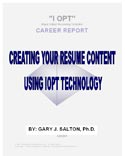
Creating Resume Content using “I Opt” Technology ~ 20 min
This video shows how the Career Report can be used to identify and develop the qualities, capacities, accomplishments and other material that combine to create compelling resume content. The video takes the viewer step-by-step through the process.
Keywords: “I Opt”, resume, chronological, functional, technical, core competencies, specifics, cpability summary, formats, career navigation.

“I Opt” Free Emotion Training Program ~ 6 min
This movie describes the content of a 66-slide PowerPoint training program available free from iopt.com. The slides have full text annotation and audio narration (in the notes section). Exercises and discussion topics are included.
Keywords: Emotional Intelligence, Social Intelligence, mirror neurons, emotions, feelings, cascades, strategic styles, patterns, long-term, short-term, stress responses, culture, management, strategies, attributions, executive

“I Opt” Technology vs. Psychological Assessents ~ 9 min
This movie explains how ‘I Opt” differs from the various psychological tests available.
Keywords: MBTI, Myers-Briggs, scope vs depth, durability, style names, reports, field experience
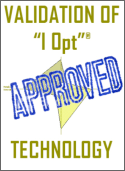
“I Opt” Validation Summary ~ 9 min
This movie summarizes the “I Opt” Validation Study in easily accessible language. It summarizes each of the 8 validity tests (plus reliability) and shows how these tests work together to create high confidence in “I Opt” technology.
Keywords: Validity, content validity, construct validity, face validity, predictive validity, concurrent validity, discriminant validity, convergent validity, conclusion validity, reliability, theoretical integrity, individual validation, group validation

Setting your Optimal Team Size with I Opt ~ 5 min
How to set your optimal team size with i-opt and organizational engineering.
Keywords:Team building, team size, transaction, cost, channels, Organization Development, bureaucracy, exponential, cost
Organizational Engineering - Leadership, Diversity, and the Goldilocks Zone ~ 15 min
This movie shows why teams offer an advantage for certain kinds of problems. It also shows why there is an inescapable decline in performance as team size increases over defined limits.
Keywords:Team building, ”I Opt“ team size, leadership, thought diversity, information processing, Measurement, organizational Engineering

“I Opt” and Communications ~ 10 minutes
The “why” and “how” of communication are explained in practical terms. It shows how a universal process will behave differently when using different channels. You learn about the many buttons you can push to get your message across.
Keywords. Communication, “I Opt”, transaction channel, communications channel, failure paths

Applying “I Opt” for Communications Success ~10 minutes
This video outlines how to use a mini-system of three ”I Opt“ tools. They offer varying levels of precision and apply to both individuals and groups. All are available free to certified individuals and established client firms.
Keywords: Communication, ”I Opt“, Snowflakes, ”I Opt“ Card deck, tools, goal directed strategies, consensus, majority

”I Opt“ and the Kolb Model ~10 minutes
How to use ”I Opt“ in learning is explained and illustrated. It’s relationship to and compatibility to (not identity with) the Kolb Learning Model is outlined.
Keywords: Learning, ”I Opt“, Organizational Engineering, Kolb Learning Model, classroom, instructor alignment, comparison
For Scholars
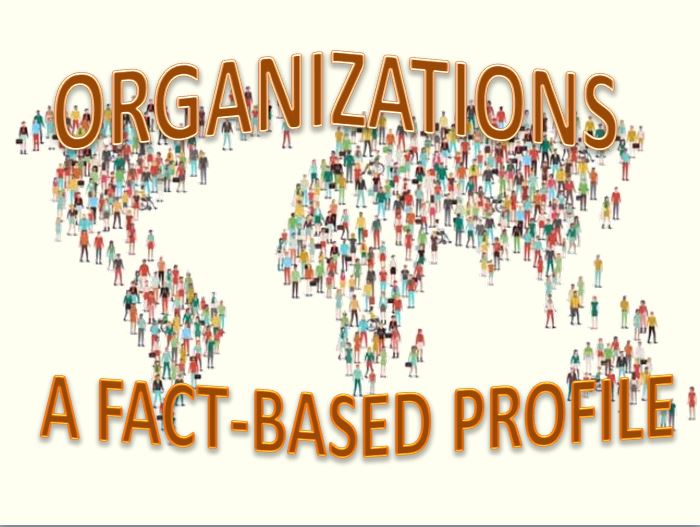
Organizations: A Fact-Based Profile ~ 22 MIN
This video reports on the use of the "I Opt" database to develop an evidenced-based model of organizational design. The research draws on 77,442 respondents domiciled in 115 different countries and affiliated with 5,549 unique organizations. The research is able to demonstrate that organizations have autonomic capacities which can maintain an organization without conscious guidance. The traditional hierarchical pyramid is appended to this base. It serves to provide rational guidance enabling the organization to optimize its ability to handle disruptive events and to sustain itself into the future. These organizational components are measurable and their relationships can be quantitatively defined. Operating together these components form an ecosystem which behaves as a single intelligent entity.
Keywords: "I Opt", I Opt, I-Opt, information processing, strategic styles, strategic patterns, hierarchy, top management, senior management, mid-management, 1st Level management, measurement, data, inference, autonomic, rational, conscious.

Thought Diversity — Professional Staffs ~ 15 MIN
This video summarizes a study that measured thought diversity for 13 professional staffs using a sample of 11,267 professionals from 1,015 different organizations located in 35 different countries. The study found that the level of thought diversity is set by the nature of the job. The study shows that the the choice of a particular diversity level is a tradeoff between equally desirable organizational qualities. The video reveals how the diversity levels involved in this tradeoff can be measured and managed.
Keywords: "I Opt", I Opt, I-Opt, thought diversity, commonality, management, information processing, profile, coordination, communication, measurement, Human Resources, medical, engineering, scientist, sales and marketing, TeamAnalysis, LeaderAnalysis

Organizational Rank and Strategic Style ~ 16 MIN
A study of 10,617 executives from 1,559 different organizations disclosed a systematic, statistically significant relationship between “I Opt” Strategic Styles and organizational rank. Different styles are favored at the different levels in the hierarchy. Applying the basic information-processing paradigm (input>process>output) to the data revealed that the observed style distribution across ranks was caused by a single factor that is an inherent quality in any organization. As an inherent, inescapable quality it can be relied upon to inform decisions in organizational design and operations as well as providing personal career guidance.
“I Opt”, strategic style, research, CEO, manager, director, Vice President, structure, hierarchy, tactics, strategy, operations, mission, resolution, uncertainty, opportunity, incentive, horizon.

K-12 School System Management ~ 17 MIN
A study of 208 principals, 218 teachers and 37 school district superintendents revealed an organizational fault in the management structure of the average K-12 school system. The existence of this flaw is likely to compromise the success of any initiative from any source targeted toward the improvement of K-12 educational performance. The fault does not reside at any particular level in the school hierarchy. Rather it is the result of the information processing relationships between organizational levels.
“I Opt”, strategic style, teacher, superintendent, principal, school board, research, CEO, manager, director, management, structure, managerial gap, idea-analysis, hierarchy, centroid.

The Professors ~ 15 min
A study of 254 professors from 109 universities revealed an important and previously unrecognized value of the tenure system. Tampering with the tenure system can have serious unintended societal consequences. The study also uncovered and quantified two different kinds of professors who together are responsible for the creation of reliable knowledge-a key university mission. A corollary condition was exposed which acts to systematically compromise student learning.
"I Opt", university, professor, adjunct, tenure, tenure track, strategic style, teaching, research, academic, stereotype, reliable knowledge, ideas, analysis, process, theories

"I Opt" Style Reliability Stress Test ~ 10 min
A test-retest study was a natural experiment. The conditions were such that participants were trying to change their "I Opt" style diagnostics. This introduced a "stress" element in which the test was biased against reliability.
The sample of 171 test-retest sets was obtained from a population of 6,298 surveys. The results show that "I Opt" reliability outperformed four traditional instruments (i.e., MBTI, DiSC, Firo-B and 16PF) even while being tested under stress conditions.
"I Opt", reliability, measurement, test-retest, analysis, strategic style, strategy, organization, development, organizational engineering, diagnosis, MBTI®, DiSC®, Firo-B®, 16PF®

"I Opt" Pattern Reliability Stress Test ~ 15 min
A study was conducted to determine the reliability of "I Opt" patterns-sequences of predictable style behaviors. These behaviors are probabilistically defined rather than narratively described. The study demonstrates that "I Opt" is able to meet or exceed any reasonable standard of reliability both for scholarly and professional applications. The study also established that the "I Opt" survey could not be manipulated and that the participants were actively trying to change their initial diagnosis (i.e., the "stress" element of the stress test).
"I Opt", reliability, strategic pattern, style, measurement, test-retest, analysis, strategic style, strategy, organization, development, organizational engineering, diagnosis

City vs. Corporate Executive Management ~ 8 min
(Opportunities and Exposures)
This video contrasts the executive level of city and corporate management structures. It uses a sample of 175 city executives from 19 cities in 10 states. The corporate sample uses 4,963 executives from 882 for profit firms. The study reveals that cities are proportionately stronger in both idea generation and analysis. This condition creates opportunities in the potential for creative ideas successfully applied. It also creates exposures in increased cost, higher tension and lengthening decision time. The video shows how organizational engineering can be applied to magnify city executive strengths and offset their vulnerabilities.
Keywords: "I Opt", leader, leadership, styles, strategies, executive, cities, municipalities, corporations, tension, ideas, analysis, strategy, organization, development, organizational engineering, diagnosis, TeamAnalysis™, savings, creativity, strengths, vulnerabilities, team
Changes In WorldView: Alcoholic Recovery ~ 15 min
This video summarizes evidence-based research that measured the change in worldview as a recovering alcoholic progresses from short-term through mid-term to long-term sobriety. The research found that this change occurs in two distinct phases. "I Opt" strategic styles were used to measure the changes in both amounts and direction. The video then summarizes two application research studies that trace the cause of the sequencing and direction of the observed changes. It also explores the structural components of Alcoholics Anonymous that support this process. The video shows that the worldview of the recovering alcoholic changes in predictable, explainable and substantial ways.
Keywords: Worldview, alcholism, recovery, 12-Steps, 12-Traditions, sponsors, "I Opt" styles, strategic profiles, information processing, measurement, significance tests, sobriety, meeting, "connecting", structural compatibility
“I Opt” Gender in the Executive Suite ~ 9 min
This movie outlines "I Opt" research into whether executive men and women differ in the way they make decisions. It explains in easily understood, but technically accurate terms the basis and the findings of the study. It also demonstrates how I Opt can be used to address major policy and social issues.
Keywords: "I Opt", leader, leadership, styles, strategies, executive, Vice President, Director, Manager, decisions, Mann-Whitney, men, women, males, females, sample size, glass ceiling, gender differences

Setting your Optimal Team Size with I Opt ~ 5 min
(Also appears in "For Professionals section")
This is the first of a two-part series. This part demonstrates that human biology sets the limits of team size. It draws on a large sample of teams to demonstrate that the theoretical limits are empirically verified in practice.
Keywords:Team building, team size, transaction, cost, channels, Organization Development, bureaucracy, exponential, cost
Why There is an Optimal Team Size ~ 14 min
(Also appears in "For Professionals section")
This is the second of the two-part series. This shows that diversity sets the "benefit" side of the team size equation. The video then shows how diversity benefit interacts with transaction channel cost (see Optimal Team Size video). The result is a cost/benefit ratio that explains why the "Goldilocks Zone" exists.
Keywords:Team building, ”I Opt“ team size, leadership, thought diversity, information processing, Measurement, organizational Engineering